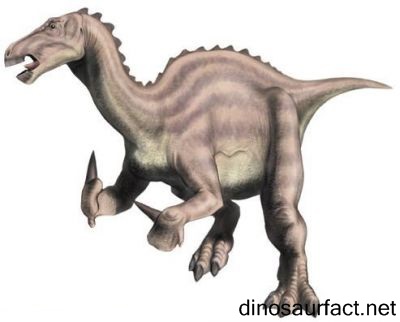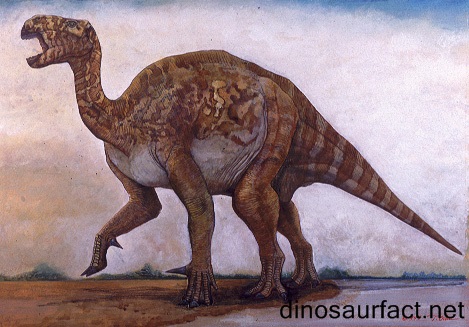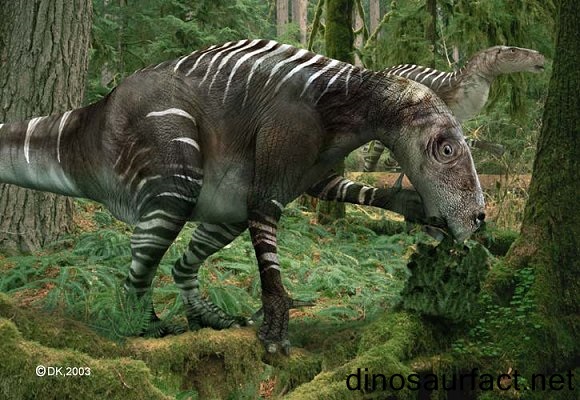 Click to visit the previous dinosaur bio
Click to visit the previous dinosaur bio
 |
|
 |
|
Kingdom: Animalia
Phylum: Chordata
SuperOrder: Dinosauria
Order: Ornithischia
SubOrder: Ornithopoda
Family: Iguanodontidae
Genus: Iguanodon
 |
|
 |
|
 |
|

Introduction
The Iguanodon was a large ornithischian dinosaur that lived in the on the earth in the early Cretaceous period. It was the second dinosaur ever to be discovered and named. Its fossils were first discovered in the year 1825. At that time, very little was known about dinosaurs; in fact the clade Dinosauria was not defined then. The only known dinosaur then was the Megalosaurus, and there was a lot of confusion about it.
The Iguanodon was an almost toothless reptile with a keratinous beak. The original teeth ascribed to it were long and sharp. As it turned out, those teeth belonged to a different dinosaur, the Therosaurus. Its walking habits were debated too, with initial studies stating that it could assume a bipedal posture. But subsequent research has shown that it was likely for the Iguanodon to support itself on its hind legs.
For a long time, it was treated as a 'wastebasket genus', which means any fossils which could not be appropriately defined were classified under it. The same was the condition of genus Megalosaurus. Due to this, genus Iguanodon was cluttered with fossils from many other genera, which made describing it so much more difficult.
The phase of its existence is judged to be about 125 million years ago, in the Barremian and Aptian ages. It geographic range is restricted to Europe, but similar fossils have been discovered in North America, Asia and even Africa.
Nomenclature
The name Iguanodon is a combination of two words, iguana and 'odontos'. The latter is the Greek word for 'tooth'. The initial tooth that was ascribed to the Iguanodon looked like that of present day iguanas. It was first suggested that the reptile be named 'Iguanasaurus' which translated to 'iguana like lizard'. But as the iguana is in fact a lizard, this name was discarded. 'Iguanoides' (iguana like) and 'Iguanodon' were put forth as replacements and the latter was selected.
The generic name was suggested by Gideon Mantell, the discoverer of the original tooth. He did not supply a specific name, and so Friedrich Holl suggested I. anglicum, which was later changed to I. anglicus, as the tooth was discovered in England. But this species is not recognized under Iguanodon today.
The currently accepted species, the I. bernissartensis was named and described by scientist George Boulenger in 1881.
Discovery of fossils
The discovery of the remains of the Iguanodon follows a convoluted and perplexing path.
The first teeth that were ascribed to the Iguanodon was reportedly discovered by the wife of Gideon Mantel, Mary Ann. She found them in Whiteman's Quarry in Sussex while her husband was away on his medical rounds in 1822.
But Mantell has later stated it was him that discovered the teeth and not his wife. He had discovered some carnivorous prehistoric skeleton in 1820 and was more interested in reconstructing it. So the herbivorous teeth of 1822 were neglected.
The herbivorous teeth were initially dismissed as those of a fish or a rhinoceros. But Samuel Stutchbury noticed that they were like an iguana, expect they were much bigger.
In 1934, a more complete specimen was found Maidstone, Kent and was ascribed to the Iguanodon. Mantell erroneously placed the toe claw on the snout of the animal, like a horn, while reconstructing it. This dinosaur is currently named as the Mantellodon.
But the largest and most diagnostically relevant find happened in 1878 in a coal mine in Bernissart in Belgium. About 38 individuals were excavated here. Although excavation was stopped in 1881, it mine was opened again during the First World War, when the Germans occupied this region.
The specimen from the Bernissart mine were unfortunately not well maintained as the fossil preservation methods of those times were not well advanced.
Classification
The grouping of the Iguanodon was an arduous task, as the clade Dinosauria was not defined when its original fossils were discovered. It was termed as a dinosaurian in 1842, when the taxon was defined by Richard Owen. At that time, Dinosauria consisted of the Megalosaurus and the Hylaeosaurus, along with the Iguanodon.
It is currently classified under order Ornithischia, clade Hadrosauriformes and family Iguanodontidae.
Due to the fact that it was a wastebasket genus, many subspecies were ascribed to it which were classified into separate genera. Currently, only one species is recognized, the I. bernissartensis. The I. ottigeri maybe a subspecies, but its existence is dubious.
Physical features
The Iguanodon was quite a large dinosaur. It was initially estimated to be around 60 feet in length, but modern calculations restrict the largest known specimen to be around 43 feet. It likely weighed 3.5 to 3.8 tons.
The jaw of this dinosaur was modified to for a beak like projection which lacked sharp teeth. They were small and flat, only bearing grinding surfaces.
The limbs of the reptile were stout and stocky. Its forelimbs bore weight on three fingers. One of the digits, the thumb, had a long and sharp claw that did not touch the ground. Its little finger was flexible, and could have been used to grasp things. The digits were directed inwards while walking, as is shown by an Iguanodon footprint.
Its hind legs had three toes. They allowed the dinosaur only a slow gait.
The tail of the dinosaur was strong and stiff. This is shown by the ossified tendons at the base of sacrum, where it joins with the coccygeal bones.
Habits and habitat
The Iguanodon was a terrestrial, quadrupedal dinosaur. It was initially displayed as a conditional quadruped which could support itself on its hind with the help of its tail. But research has now shown that its tail would literally break if the dinosaur tried standing on its hind.
It was a plant eating reptile. It was thought to have a prehensile tongue, but this has been disproved based on the structure of its hyoid.
The function of the thumb claw is debatable. Some scientists believe it was used for self-defense. Others state that it could have been used to cut through thick vegetation.
A lot of fossils were aggregated in the Bernissart mine, which lead scientists to believe it lived in herds. But the absence of juvenile specimens indicates the remains could have been brought together by floods.
Its habitat consisted of vast plains which were intersected by large rivers.
Related species
The Iguanodon was related to the Ouranosaurus. It is possibly synonymous with the Hikanodon.
Concluding notes
Despite its numerous fossils, the Iguanodon is not completely understood. Better preserved fossils would be needed to comprehend it well.
Index
Extinct Profiles
 Triassic Dinosaurs
Triassic Dinosaurs Jurassic Dinosaurs
Jurassic Dinosaurs Cretaceous Dinosaurs
Cretaceous Dinosaurs Pterosaurs
Pterosaurs Marine Reptiles
Marine Reptiles Dinosaur Extinction
Dinosaur Extinction